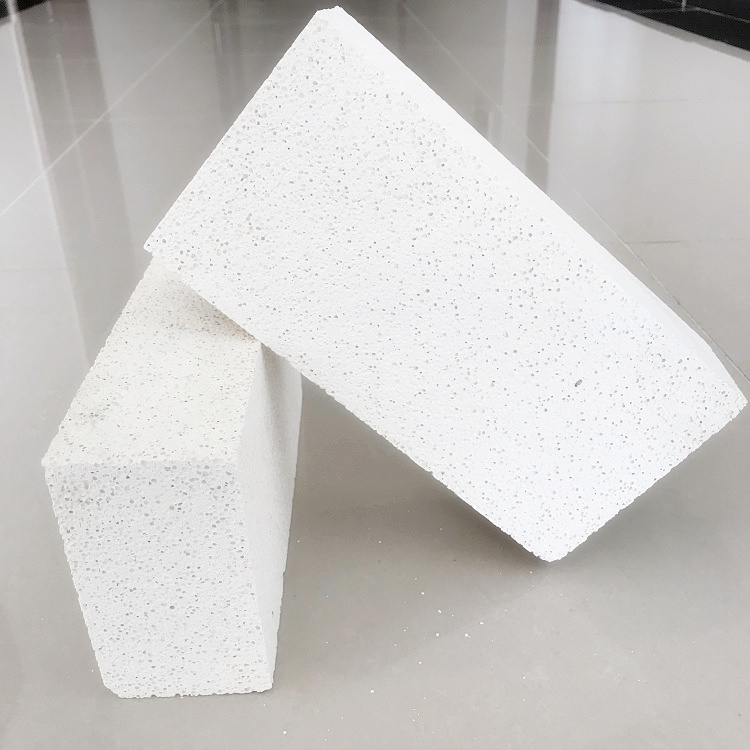mullite insulating refractory bricks
Classification:
Product Introduction
Mullite insulating brick is a kind of thermal insulation refractory material with excellent performance, which is mainly composed of mullite (3Al₂O₃·2SiO₂). Mullite is a high-quality aluminosilicate mineral, and this component gives bricks good high-temperature properties. It has a stable crystal structure with its crystals in the form of needles or columnars. This structure enables mullite thermal insulation bricks to maintain good mechanical strength and stability at high temperatures, and is not easy to deform or be damaged.
Performance characteristics of mullite thermal insulation bricks:
1. High temperature resistance
Mullite insulating bricks have a high degree of fire resistance and can generally withstand high temperatures of 1600 - 1790°C. For example, in high-temperature environments such as glass furnaces, it can work stably for a long time and effectively resist the damage of high temperature to the furnace structure.
2. Low thermal conductivity
It has a very low thermal conductivity, typically between 0.8 - 1.3 W/(m·K). This means that it is able to effectively block the transfer of heat and act as a good thermal insulator. When used in industrial kilns, it can significantly reduce the heat dissipation loss of the kiln and improve energy utilization.
3. Good thermal shock resistance
Mullite insulating bricks maintain good integrity in the face of rapid temperature changes. This is because the mullite crystal structure has a certain adaptability when the temperature changes, and it is not easy to crack. In batch furnaces, for example, it can still function during frequent heating and cooling processes.
4. Chemical stability
It has good resistance to both acidic and alkaline media. In the kilns of metallurgy, chemical and other industries, it may come into contact with various acids and alkalis, and mullite insulating bricks can resist the erosion of these substances and prolong their service life.
Application fields of mullite insulating bricks:
1. Metallurgical industry
It is used as a lining material in heating furnaces and refining furnaces for steel and non-ferrous metal smelting. It provides a stable thermal environment for metallurgical processes while reducing heat loss, improving energy efficiency, and resisting the erosion of high-temperature metal melts and slags.
2. Ceramic industry
Kilns used for ceramic firing, such as roller kilns, shuttle kilns, etc. Its low thermal conductivity can ensure the uniformity of temperature in the kiln, which is conducive to the uniform firing of ceramic products and improves product quality. Moreover, its good thermal shock resistance can adapt to the frequent opening and closing of ceramic kilns and temperature changes.
3. Chemical industry
It is used in chemical reactors, cracking furnaces and other equipment. In the process of chemical production, complex environments such as high temperature and corrosive media are often involved, and mullite thermal insulation bricks can effectively insulate and resist chemical corrosion to ensure the normal operation of equipment.
| Projects | Physical and chemical indicators | |||||||
| MG-23 | MG-25 | MG-26 | MG-27 | MG-28 | MG-30 | MG-32 | ||
| (Al2O3)/% | ≥ | 40 | 50 | 55 | 60 | 65 | 70 | 77 |
| (Fe2O3)/% | ≤ | 1.0 | 1.0 | 0.9 | 0.8 | 0.7 | 0.6 | 0.5 |
| Bulk density/(g/cm3) | ≤ | 0.55 | 0.80 | 0.85 | 0.90 | 0.95 | 1.05 | 1.35 |
| Compressive strength at room temperature/Mpa | ≥ | 1.0 | 1.5 | 2.0 | 2.5 | 2.5 | 3.0 | 3.5 |
Heating permanent line change/% (T/°C×12h) | Test temperature | 230 | 1350 | 1400 | 1450 | 1510 | 1620 | 1730 |
| Xmin~Xmax | -1.5~0.5 | |||||||
| Thermal conductivity/[W/(m. K)] ≤ (average temperature ± 25°C) | 200 | 0.18 | 0.26 | 0.28 | 0.32 | 0.35 | 0.42 | 0.56 |
| 350 | 0.20 | 0.28 | 0.30 | 0.34 | 0.37 | 0.44 | 0.60 | |
| 600 | 0.22 | 0.30 | 0.33 | 0.36 | 0.39 | 0.46 | 0.64 | |
| 0.05Mpa load softening temperature T0.5/°C | ≥ | 1080 | 1200 | 1250 | 1300 | 1360 | 1470 | 1570 |
Key words:
mullite insulating bricks
Related Products
Product inquiry


